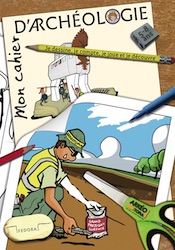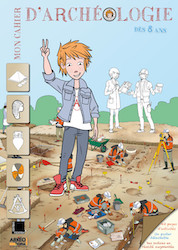Inventorying Cultural Heritage, a Wonderful Tool for Archaeologists
- Last Updated: Tuesday, 28 June 2022 09:22
- Published: Saturday, 16 April 2022 09:11
- Written by Jean-Olivier Gransard-Desmond translated by Ch. Angibous-Esnault and M. Schmitt
- Hits: 1466
Join Augustin, Alex, Lisa and the whole ArkeoTopia team to discover additional resources for step 2.6 in My Archaeology Book about locating ancient human occupations through campaigns for inventorying cultural heritage.
Step 2.6 - Locating Archaeological Remains
Inventorying Cultural Heritage
Corresponding pages in MAB1 and MAB2
MAB 1, p. 11 (step 1.2 on p. 5 in previous versions) and MAB 2, pp. 14-15
More about this step’s reference artifact
 Are you familiar with the Institute of Art and Archaeology, also called the Michelet Center? This building in the 6th district of Paris is located between 6 avenue de l'Observatoire and 3 rue Michelet, at the edge of the Luxembourg Garden. Until a few years ago, it housed the art history departments of the universities Paris I and Paris IV, some of which have now moved. It was designed by the architect Paul Bigot between 1925 and 1928. Since September 9, 1996, it has been classified as a historical monument. It was the subject of a report by Christian Hottin (in French), of the Architecture and Heritage Department (Direction de l'architecture et du patrimoine), available on the open archive HAL Human and Social Sciences (HAL Sciences de l'Homme et de la Société) website, which is intended for the deposit and diffusion of scientific articles.
Are you familiar with the Institute of Art and Archaeology, also called the Michelet Center? This building in the 6th district of Paris is located between 6 avenue de l'Observatoire and 3 rue Michelet, at the edge of the Luxembourg Garden. Until a few years ago, it housed the art history departments of the universities Paris I and Paris IV, some of which have now moved. It was designed by the architect Paul Bigot between 1925 and 1928. Since September 9, 1996, it has been classified as a historical monument. It was the subject of a report by Christian Hottin (in French), of the Architecture and Heritage Department (Direction de l'architecture et du patrimoine), available on the open archive HAL Human and Social Sciences (HAL Sciences de l'Homme et de la Société) website, which is intended for the deposit and diffusion of scientific articles.
This step illustrates part of the process of inventorying cultural heritage. This is a very important action for archaeologists, especially ones working on the medieval period and more recent periods, as it ensures that all cultural heritage which could be destroyed one day is preserved in registers with different information such as photos, drawings, GPS coordinates, construction date, materials, etc.
In the drawing, Lisa the archaeologist takes notes and draws. Meanwhile, Alex the archaeologist takes a picture with his camera. They are recording information about the building in front of them. This is the job of scientists who conduct inventory campaigns. These campaigns can take place in cities, villages, the countryside and even forests. Here, the street sign and the building’s decorative elements help us understand where the action takes place: at the southeast corner of the Institute of Art and Archaeology (Institut d’Art et d’Archéologie). This methodology enabled ArkeoTopia to see that the buildings of the Irish College had not been the subject of an archaeological study.
Clues
The 6 clues include:
- Lisa, the archaeologist
- Alex, the archaeologist
- The camera
- The notebook with the pencil
- The street sign
- The building itself, the Institute of Art and Archaeology
Geophysical SurveysMy Archaeology Book
Resources HomepageStep 3 - Funding
Seeking Money
 |
 |
|
My Archaeology Book 1 |
My Archaeology Book 2 |

 My Archaeology Book, or MAB, is an activity workbook that combines creativity, fun and learning. Alongside young Augustin, a curious and courageous boy, children meet Alex and Lisa, two friendly archaeologists who will lead them to discover archaeology and French heritage. Each drawing illustrates a situation that Alex and Lisa might encounter at work. Depending on the age of the child and the workbook, children follow easy-to-understand symbols in order to experiment with activities such as coloring, drawing, observation games, riddles and reading in order to see the world through an archaeologist’s eyes. Alone, with family, at school or just for fun, children expand their knowledge and gain skills, all while having fun.
My Archaeology Book, or MAB, is an activity workbook that combines creativity, fun and learning. Alongside young Augustin, a curious and courageous boy, children meet Alex and Lisa, two friendly archaeologists who will lead them to discover archaeology and French heritage. Each drawing illustrates a situation that Alex and Lisa might encounter at work. Depending on the age of the child and the workbook, children follow easy-to-understand symbols in order to experiment with activities such as coloring, drawing, observation games, riddles and reading in order to see the world through an archaeologist’s eyes. Alone, with family, at school or just for fun, children expand their knowledge and gain skills, all while having fun.
On this section, you will find additional resources: color photos of archaeological documents that inspired My Archaeology Book, additional teaching documents (flip-book, websites, suggestions for classroom use, edutainement, etc.) and information on upcoming publications. Each page will be updated over time.






